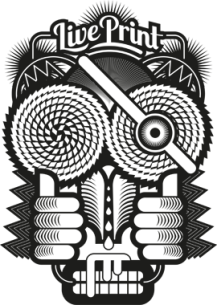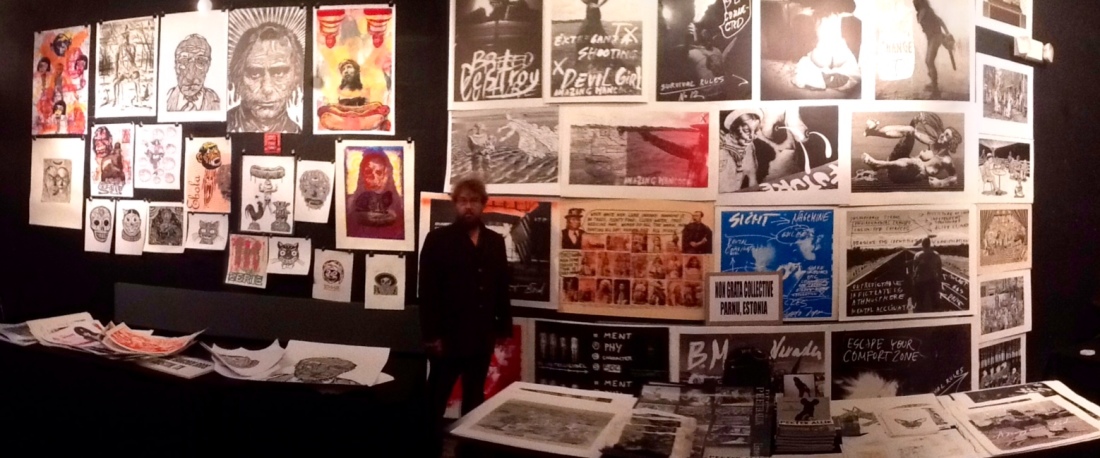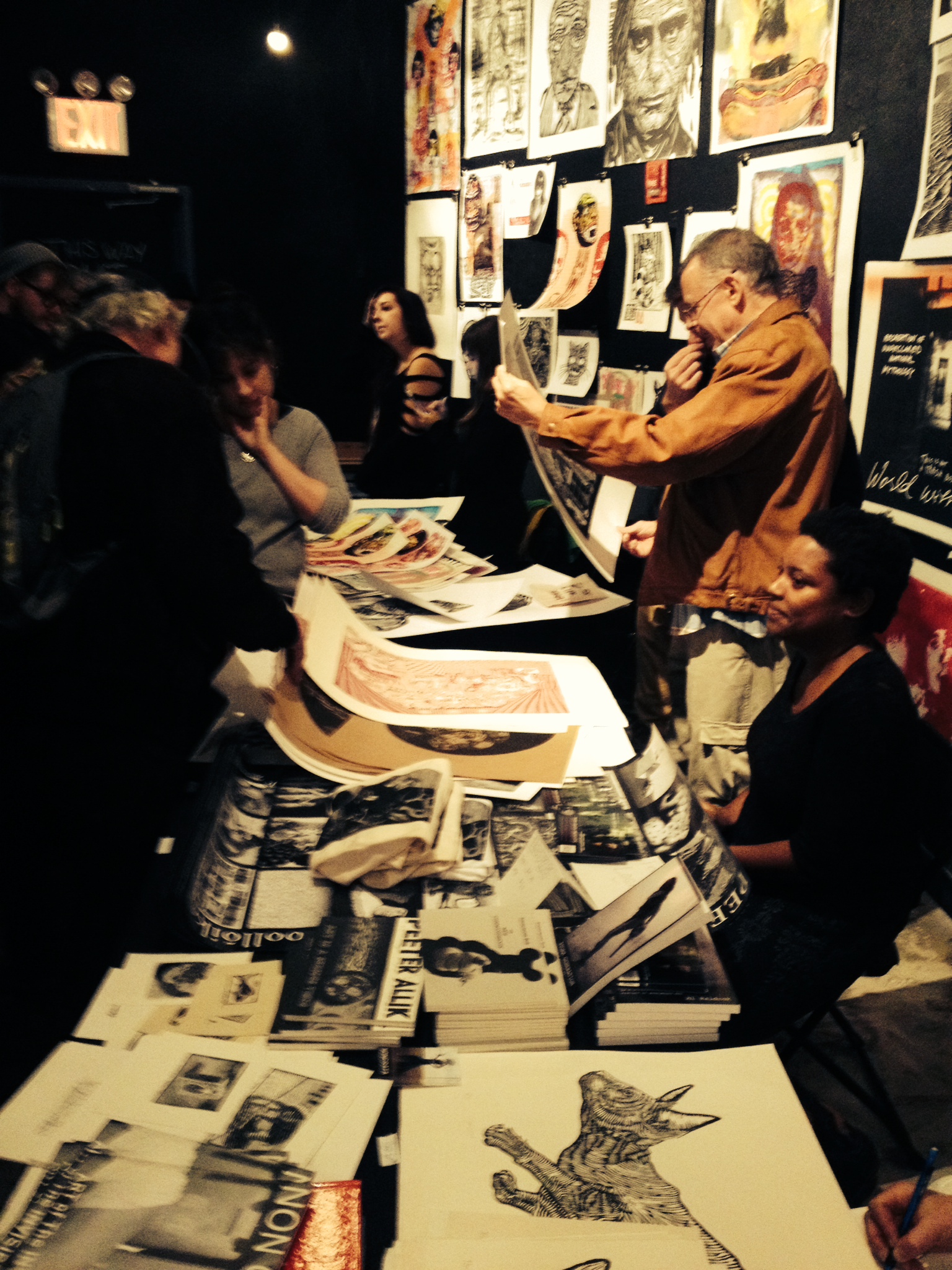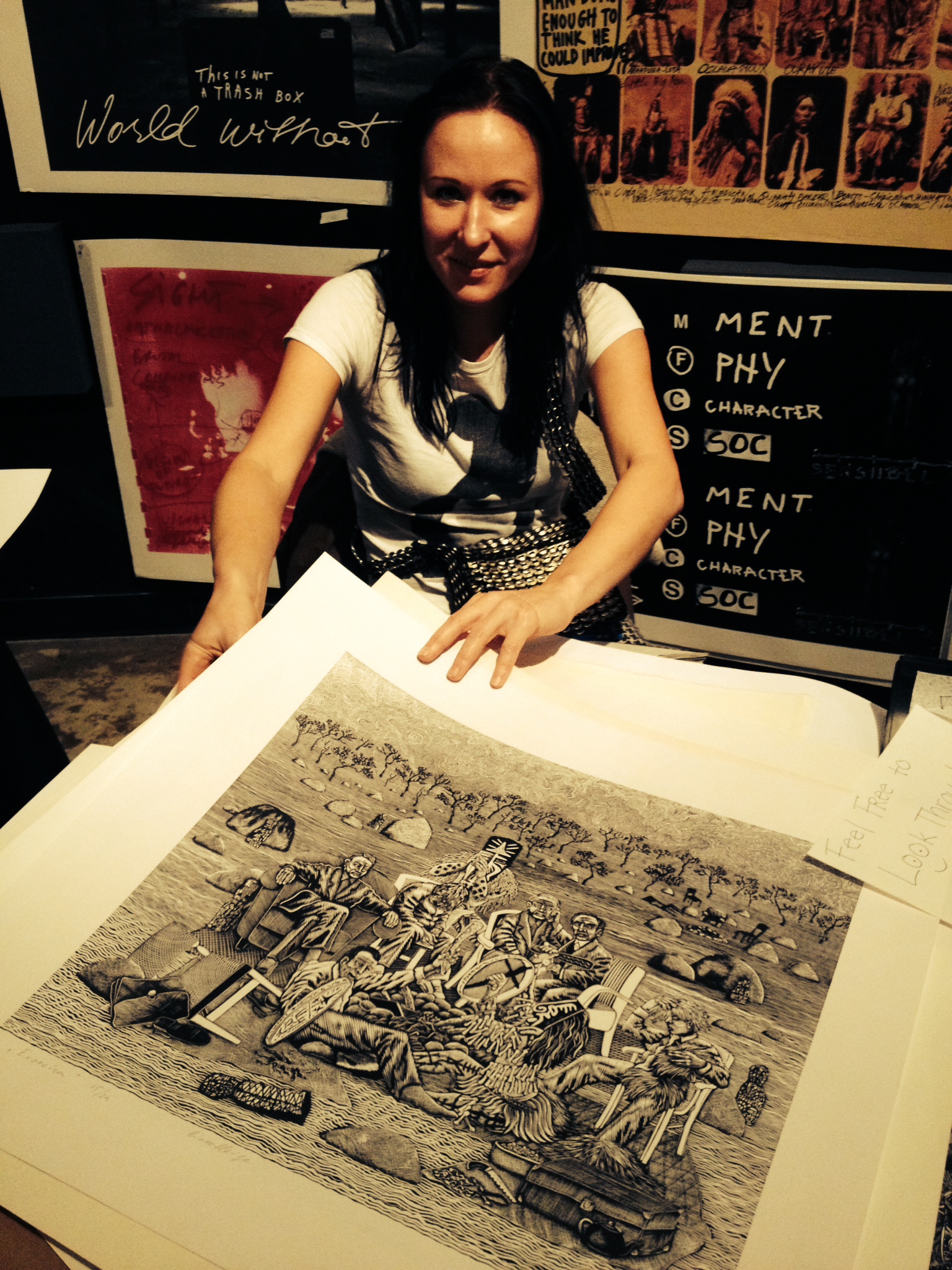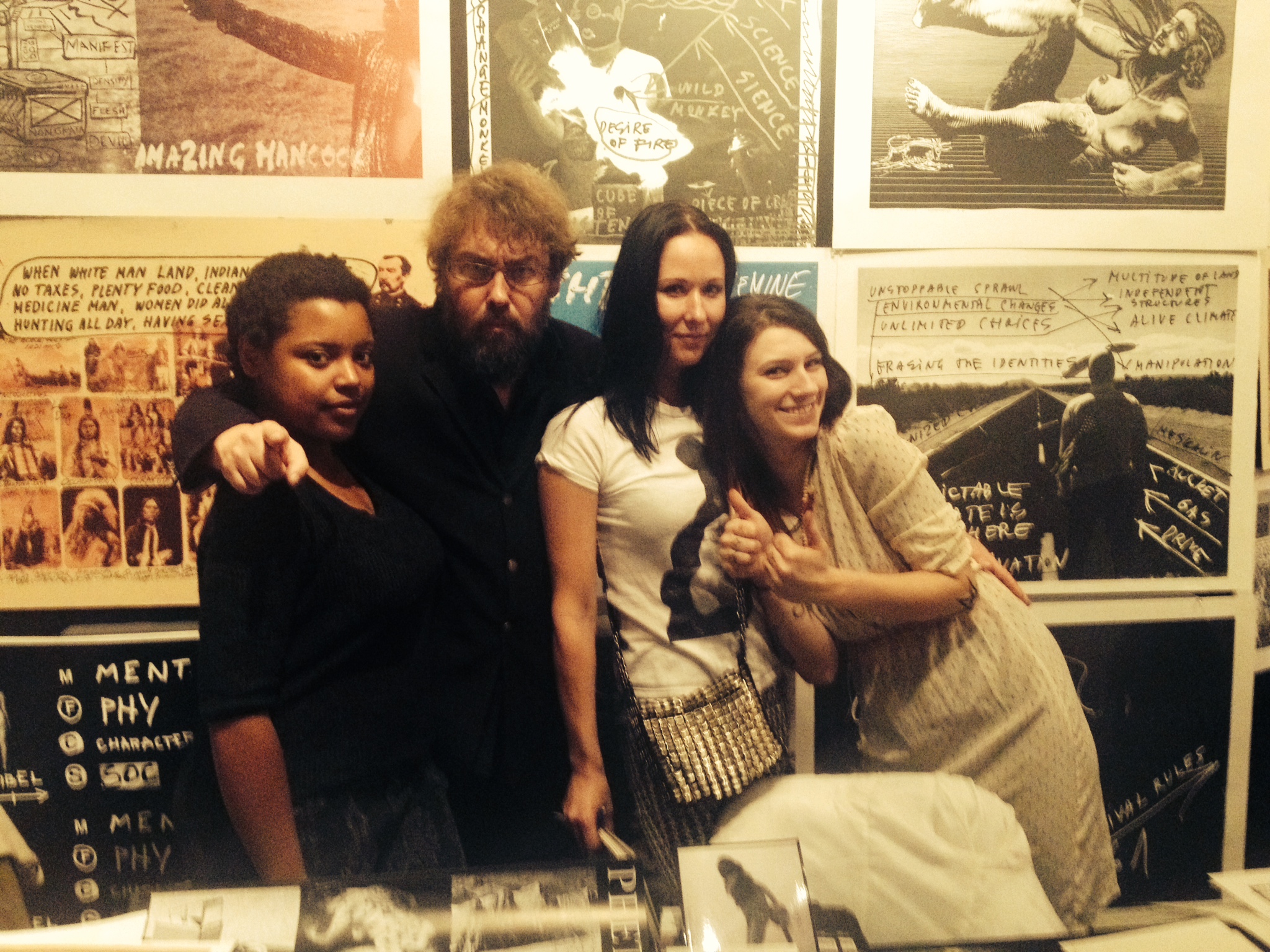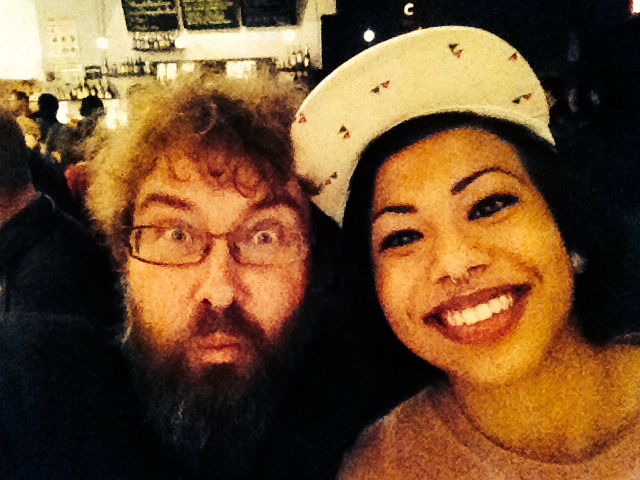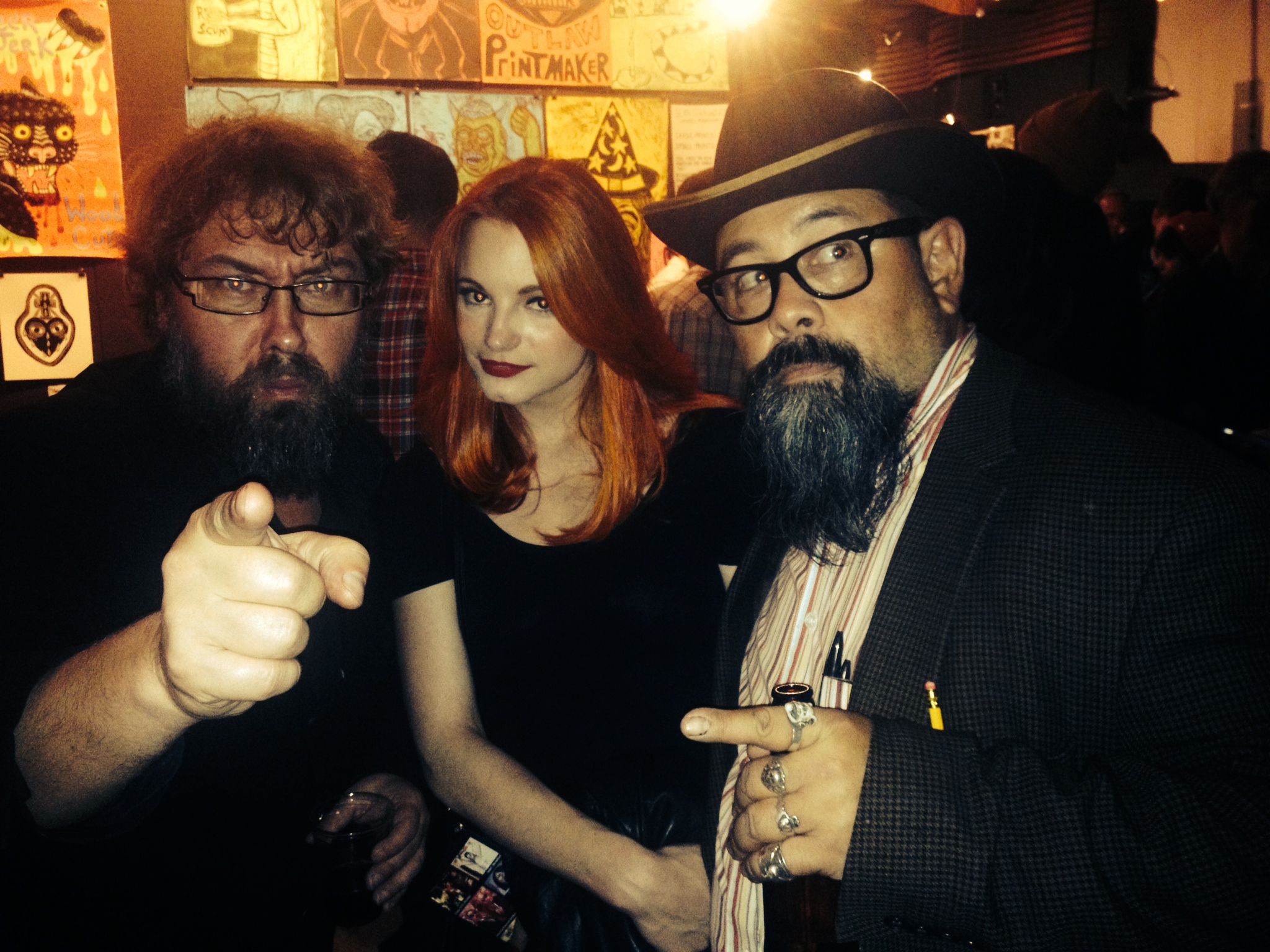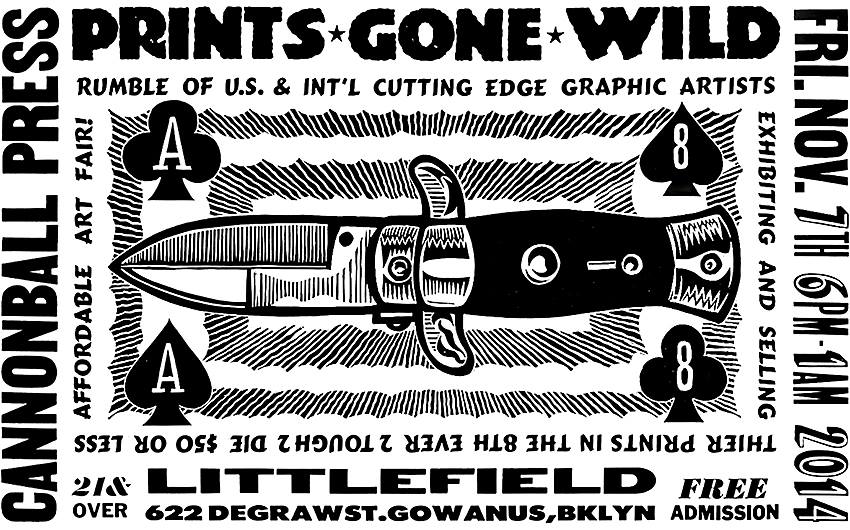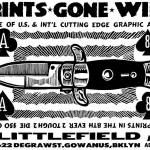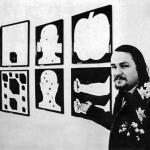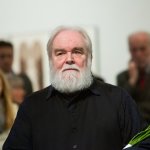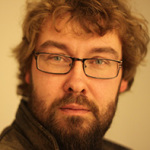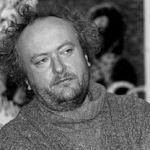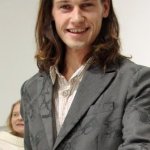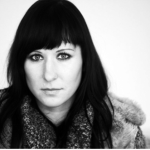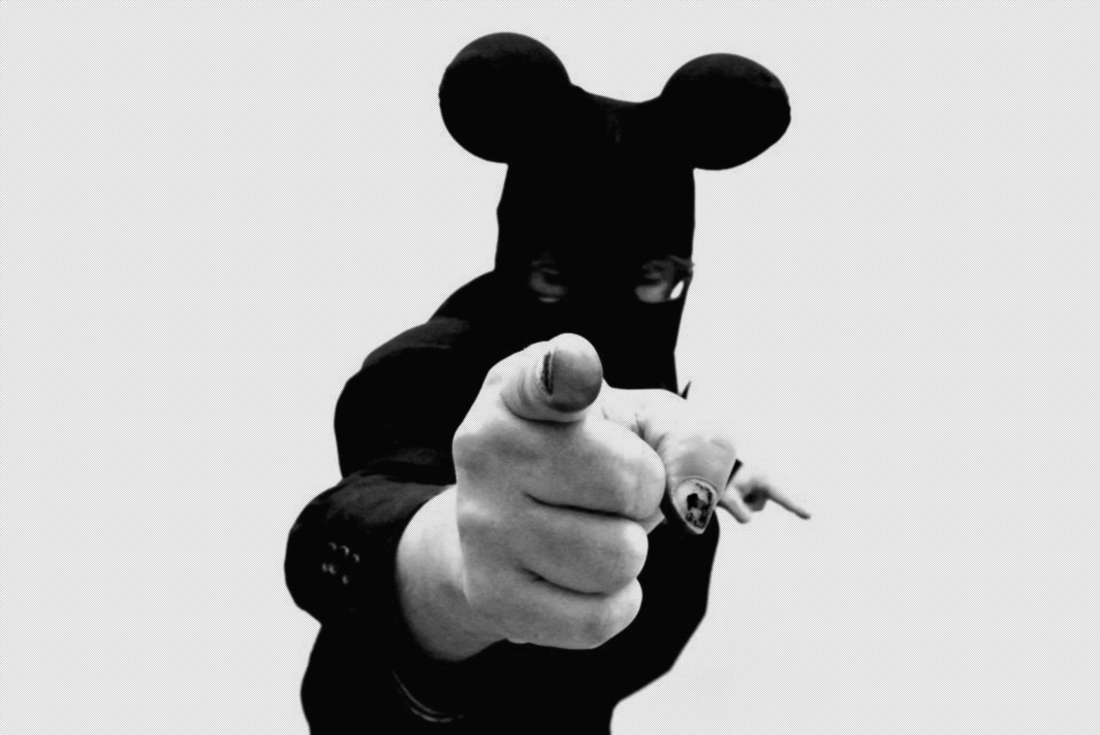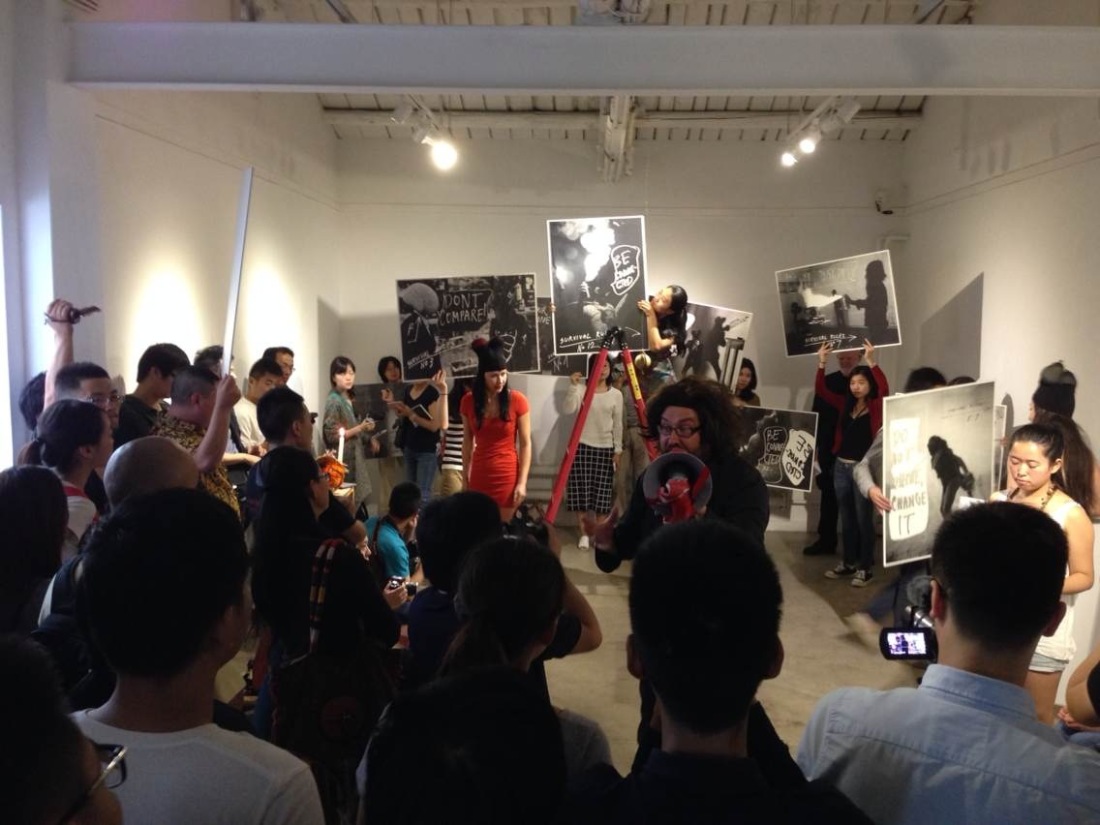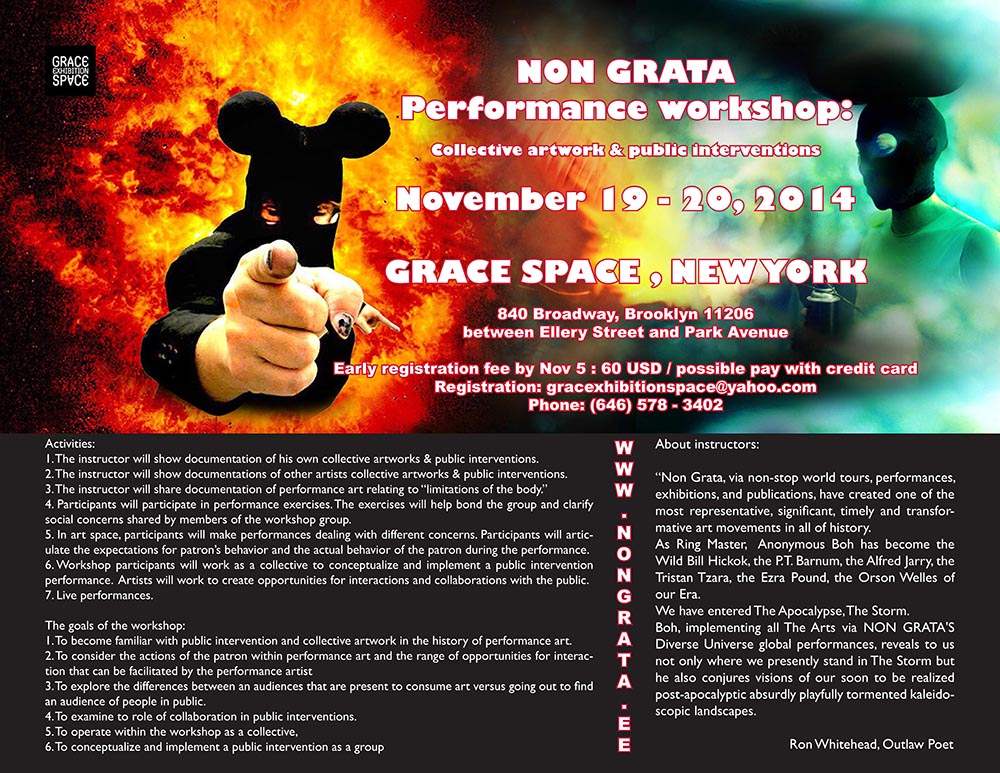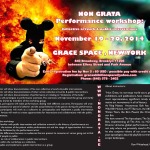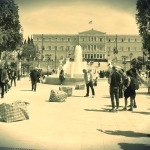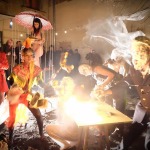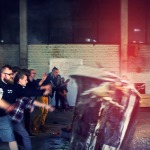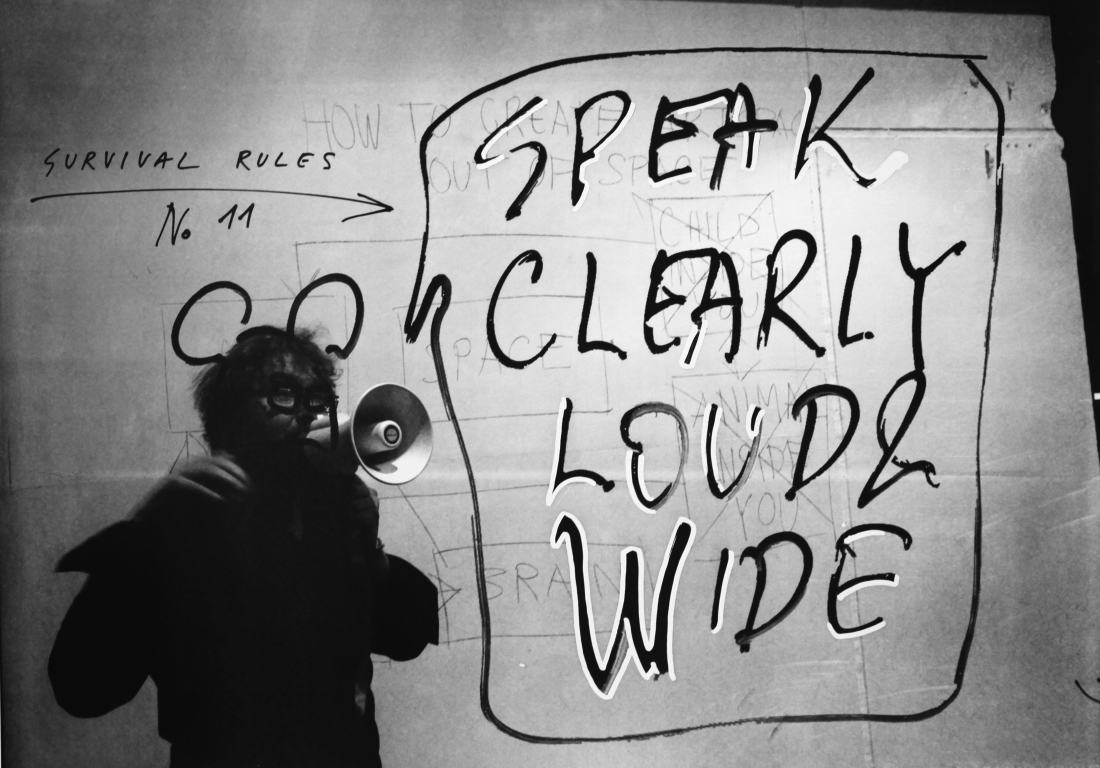Estonian artists are into some weird shit
Published in aweh.tv By Dann Gaymer on 3/9/12
As a key lynch pin of the NON GRATA performance group, Estonian artist Anonymous Boh has been creating and reimagining for the past two decades. With performance, art tours and lectures, across Asia, Europe and the Americas, NON GRATA has breathed a fresh life in performance art, and into the wider discourse of what art should be and what it should do. As a teacher of the Academia Non Grata program Anonymous Boh helped propagate a different approach to freeing the minds of young artists, in sharp contrast to the rigid and formulaic teaching methods of so many European schools. Today this mission continues albeit on a wider scale, when NON GRATA arrive in a foreign city, breezing in like a pirate nation and calling on a network of sleeping participants to come out and create something for the sake of creation, not to give answers but to pose questions.
While Anonymous Boh’s artist CV reads like an adventure novel, he has done an excellent job of doing exactly what his name suggests and removing himself from the work, along with the rest of NON GRATA. While he has performed at Seoul’s KEAF festival before this year’s performance will be worth witnessing, nay, participating in, because there is no way of telling what it will entail. Structured chaos will reign.
AWEH sat down with the man with barely a name to find out about the art environment of Estonia as of recent, where he feels NO GRATA’s mission is at, and what challenges the art world still needs to address.
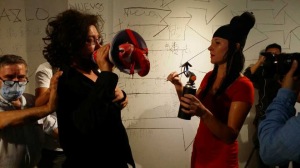
AWEH: Who are you and what do you do?
Anonymous: I am Anonymous Boh from NON GRATA group. NON GRATA is an international performance group from Estonia with floating membership. In NON GRATA there has been more than 500 members during last fifteen years from all over the world. The main characteristics is anonymity in group work, ignorance of the local art world, and mass media. The group has performed in Asia, Europe, South and North America with street actions, chaotic space and context specific performances, and long lasting ghetto marathons.
AWEH: How did you become interested in art and begin to follow it as a profession?
Anonymous: I have been in art all my life since I was six and just step by step it is now full time profession.
AWEH: How is the art scene in Estonia?
Anonymous: The art scene is quite active if we compare that only 1 million people live in Estonia — it is the smallest nation in the mainland in world with their own state, written language, and national TV.
AWEH: Is it possible for artists to support themselves through non-commercial ventures?
Anonymous: Theoretically of course, everything is possible, practically I am not so sure.
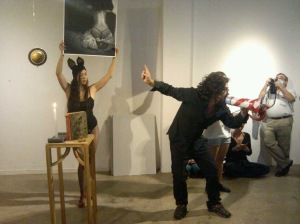
AWEH: What inspired NON GRATA at its inception as a school?
Anonymous: Academia Non Grata was founded after the Soviet Union collapsed. The fact that we witnessed the collapse of a whole Soviet system gave a unique angle of approach that was unprecedented in the West. At first [early 1990s] there were many cultural figures in the Estonian Parliament. Had they kept the cultural level and the other things together, had they taken the responsibility that used to belong to the church and during the Soviet times to the state, so that there were not just the laws of the jungle, but various structures, then there might have formed a common understanding of what it really is we’re doing. A country from which Tony Blair could have learnt a lesson about the third route, not a country with a Prime Minister being a Thatcher disciple.
In the middle of ‘90s results of this direction was clear — Estonia was typical early capitalistic society, where everything was calculated by money only. The mental discussion about what a person could do during the period between birth and death and how the state could support him was ended. What it was worth being born for? With what kind of people one wants to spend one’s life? Self-censorship of the people, including the intellectuals, has reached unbelievable dimensions. Everything that is, is good. It is considered frantically shameful to think about what could be: maybe it makes me a loser? Maybe a dreamer?
The body of artists (intellectuals) has ceased to act according to their true nature and ideals, the prevalent trends are accepted as inevitable and frenzied attempts are made to adjust to them. The art circle as a whole is no longer interested in dealing with the essential, most of the energy in the pedagogical institutions of art is wasted on formal feeding of the structure and on making formal moves. It is surprising how quickly Estonian ‘intellectuals’ were settled as a part in the machinery in the name of a little oiling.
Same problems were then in art education. The managements of the leading institutions of art education admitted that their hands are tied, because rooting of ‘unsolicited’ standards is the only way to be integrated into the greater system and avoid the terrifying status of “being left out”, as they say. I would like to know who has proclaimed this practice of absolute pragmatics to be a cognitive inevitability that is faithfully followed by the various fields of institutions of higher education and their specialists.
AWEH: What kind of methods did you employ to ensure that a student of NON GRATA wasn’t “just a good designer of bottle labels.”
Anonymous: An artist has to attempt to improve the world. The aim of the Academia Non Grata was and still is to create a mental atmosphere where people felt free to ask themselves and others: what is it that I really think, what is it that I really want? Many of our teaching methods that seem strange to the bystander, serve the very purpose of teaching a person to really step into the game. At the same time, it is still an art school. The language we use is figurative. So I cannot be blamed for not doing anything if I don’t like it. I am doing it, but with my own tools. It is not enough if an artist is just a good designer of bottle labels. Similarly it is not enough if a person is a good and successful critic, scientist or who ever. What we propagate is actually very simple — that a person should be able to sincerely look into the face of someone else and to smile without any pretence, arrogance or bootlicking. I do not think it comes naturally but rather that it needs to be learnt, like any other thing.
AWEH:Since the Academia NON GRATA educational program in Pärnu ended how has your involvement continued with NON GRATA?
Anonymous: It really did not end, we just switched to another form. After six or seven years of being a primary school of the free arts, it has ceased to be this kind of educational institution — the state-controlled higher educational system has taken over the ANG interdisciplinary courses of the arts. Accordingly, the mission of the ANG is therefore completed. Its main purpose has never been a typical art school, but it has always tried to be a place of alternative solutions, which would be developed and put into practice. The educational system of the EU as a whole has changed into an establishment so controlled, that it takes all the power, time, and resources of the students, making them deal with formalities, that have nothing to do with creative work. All the burocratic rituals take so much time, that not much energy would be left for the main purpuses. This kind of choice is made in full awareness, very well knowing that it would restrain the aftergrowth, but there are minuses that are much worse. The main object of the ANG has never been worrying about the aftergrowth; it has simply been an additional bonus in our work as healers of the society.
The ANG has switched into another system, which may be called postgraduate atelier-system, as well as the programs of lectures, “Academia on the Wheels”. The latter is meant to use institutional parasite-piracy,using the other existing material-technical bases in order to disseminate our ideas and to put them into practice.
Like from the beginning I am still active on a frameless territory where an art object has ceased to exist as a physical piece. The space has many dimensions upon which the activity has been built. Curating the performance group NON GRATA actually means creating a certain kind of school which can be characterized by features as structured chaos, performances in arbitrary environments and interiors. By obtaining its reputation as an alternative we swooped onto the global art landscape — performances, art tours organized in tens of cities across Europe, Asia, and America.
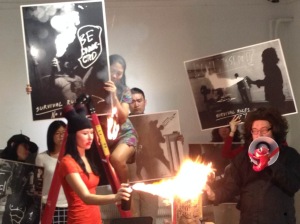
AWEH:You’ve told us about how NON GRATA’s mission was to create a break away from the mainstream in Estonia, and make art and performance substantial and meaningful again. On both a local and global level how successful has this mission been? Do you feel there is more work to be done?
Anonymous: The artists have become either the ones who satisfy society’s certain aesthetic needs, small scale entrepreneurs producing pretty things, or society’s fools officially labelled as the opponent.The global performance art is sinking in its own blood, every now and then. And NG is then asked to come and rescue it. It is as if a nomadic tribe of artists steps by and the reality is being altered. Like the story of NG written by Finns where they talk about the liberators from the incest and the orphic hole…
There is a wild creative power wave all over the world and our underground network connects it together. The universe is an experimental space and art is a creational process in a perpetual move.
AWEH:The fact that you perform anonymously seems profound when so much of art today seems tied with “getting yourself out there”. Art school graduates can seem more concerned with their public image as opposed to their creative output, but do you think this is just a fool’s errand, that will ultimately conclude in being overlooked in art history?
Anonymous: What is fame nowadays? The media is not interested in the essence of things but rather in a special format. It is very easy to produce an item that looks like art nowadays. It was a great event when Vermeer made a picture, thousands of people came to see it. Today a couple of million pictures are being produced every second in our computers and TV sets. The picture itself interests no one. People barely know the works of famous contemporary artists. It is actually possible to become famous without making any pictures, by just declaring that one makes pictures.
Apart from Andy Warhol in the art world, there are no commonly recognized megastars who would be known to any Tom, Dick and Harry. In the present condition that, by the creation of the Internet, the information society has brought about, the art world, as an institution, has not been able to address its issues nor establish its own paradigms.
I consider it an ill-service to the youth if you simply make them promote themselves and run around in circles, when a few decades have passed the person is still completely empty. The art world takes what interests it at the moment, and then throws it aside again, taking a new interesting thing. What does the person do then if one has based it all on the art world? There are many who cry: “Look what they’re doing to me, I’m no longer popular…”
If you evolve as a human being you can do anything at any time. You can become a braze welder for that matter, because you’re in charge of the process.
AWEH: You recently did a performance of Force Majeure in Chicago, where we heard a car suffered a fair amount of abuse. What is the outline for your performance during KEAF?
Anonymous: We do not know yet, only that the theme of KEAF this year is “Wheel“. Our performances are mostly context and location specific. We make no plans prior to our arrival to the place and we do not provide generally pre-required work descriptions. Everything is being decided on the spot, where we are going to perform or the performance space is being chosen due to the inspiration drawn from the actual place. Local cultural background, history, stereotypes, nature, people, politics, personal experiences are all being involved and blended together. They’ll form a mini model of a concrete society and, with its different levels, it starts to serve as a background for a concrete idea or it’ll behave as a piece of art work in itself.
AWEH:What are your overall expectations of this trip to Korea?
Anonymous: Creative environment, great people, talented artists, deep dicussions and something you never can expect.
AWEH:Any final words of love or hate to share?
Anonymous: I love Korea!
